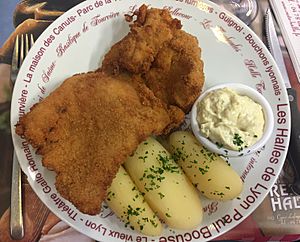Tablier de sapeur facts for kids
 |
|
| Place of origin | France |
|---|---|
| Region or state | Lyon |
| Main ingredients | Tripe |
Tablier de sapeur is a special dish from Lyon, a city in France. Its name means "sapper's apron." It's made from beef tripe, which is the stomach lining of a cow. Specifically, it uses a part called gras-double, which is a membrane from the cow's first stomach chamber, the rumen.
This dish used to be called tablier de Gnafron, meaning "Gnafron's apron." Gnafron is a famous puppet character from Lyon. Tablier de sapeur is a very common dish you can find in the traditional restaurants of Lyon, called bouchons.
What is Tablier de Sapeur?
Tablier de sapeur is a unique and traditional dish. It's known for its interesting texture and rich flavor. The main ingredient, tripe, is carefully prepared to make it tender and tasty. This dish is a big part of the local food culture in Lyon.
How It's Made
Making Tablier de sapeur involves a few steps:
- First, the beef tripe is boiled until it is soft. This is done in a special flavored liquid called a court-bouillon.
- After boiling, the tripe is marinated. This means it soaks in white wine for a while to add flavor.
- Next, the marinated tripe is coated in breadcrumbs. This gives it a crispy outside when cooked.
- Finally, it is fried until golden brown.
How to Eat It
Tablier de sapeur is usually served with a special sauce. This sauce is called sauce gribiche, and it's a cold sauce made with eggs. Fresh chives are often added to the sauce for extra flavor. Steamed potatoes are also a common side dish, making it a complete meal.
Why the Name "Sapper's Apron"?
The name "Tablier de sapeur" has an interesting history. A "sapper" was a military engineer, like a soldier who built or destroyed things. These soldiers wore leather aprons to protect their uniforms while working.
It's believed that the name changed because of a military leader. Maréchal de Castellane was a general who served under Napoléon III. He was the military governor of Lyon. People say he loved this dish and helped change its name from "Gnafron's apron" to "sapper's apron." This new name honored the protective aprons worn by the sappers.

